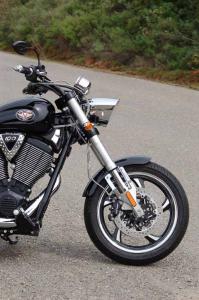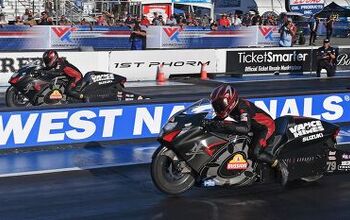Victory Vegas 8-Ball Project: "Evil 8" Part 2
Old-time hot rodders had a saying: “If it don’t go, chrome it.” Taking liberty with that age-old axiom of form over function, we looked at our Victory Vegas 8 Ball project bike, Evil 8, and concluded: “If it don’t handle, suspend it.”
No doubt, our black beauty is an eye-catcher in terms of boulevard appeal, but its eye-candy luster grows dull when we take it off the beaten path to explore a twisty canyon road. Chassis ingredients that include a 21-inch front wheel, forward foot controls and a stubby rear shock absorber create a recipe more for good looks than good handling. Simply, when variable-radius turns are put on the menu, bikes like Evil 8 need a little hamburger helper in order to satisfy our hunger for handling performance.
Evil 8 sits boldly with its new suspenders in place. The bike looks noticeably sportier with the 18-inch front wheel instead of the original 21-incher.
And so we posed the question: Must a cruiser give up handling in order to look cool? We concluded that it did not, and to prove our theory we took Evil 8 to the lab, specifically the service department at Southern California Victory, in Brea, California, for a little makeover to its suspension.
Admittedly, we took a few shortcuts along the way, leaning on data that Victory’s engineers figured out through their research and development to produce the Hammer and Hammer S, clearly the models with the best road-handling prowess in the Minnesota-based company’s lineup.
First thing we did was to cast our covetous eyes on the Hammer’s inverted cartridge fork. Its retail price is a hefty $1,999.99, but used ones can be found for a fraction of that price.
Even though the spec sheets for the 8 Ball and Hammer show 5.1 inches of suspension travel for both forks, having spent time in the Hammer’s saddle, we know for a fact that its inverted cartridge fork’s damping rates are superior to those of the 8 Ball’s traditional telescopic fork.
And while rake and trail numbers are very similar (32.9 degrees/4.9 inches for the 8 Ball; 32.7 degrees/5.5 inches for the Hammer), what caught our eye was the 18-inch diameter wheel ($399.99) spinning on the end of the Hammer’s fork. Smaller-diameter front wheels generally reward the rider with more responsive steer-in for a given turn than do larger hoops – all things remaining the same. We wanted that snappier steering input.
We were also swayed by the inverted fork’s dual-disc braking system. If one 300mm front disc brake worked good (which it did on Evil 8’s telescopic fork), then two 300mm disc brake rotors should work even better (which they do on the inverted fork). Initially, the added unsprung weight posed by the second rotor, caliper and hardware concerned us, but it was somewhat offset by the replacement fork’s inverted design. Having the sliders at the bottom of the fork legs helps minimize the amount of unsprung weight in the assembly.
We didn’t confine our makeover to just the fork. There was room for improvement in Evil 8’s hindquarters, too. The answer is found in the rear coil-over shock absorber. In the interest of making the 8 Ball a low-riding custom, Victory gave it a shock absorber that’s nearly an inch shorter than the unit found on the Hammer. The Hammer’s spring also has an additional coil winding, and the spring wire diameter is slightly smaller than that of the 8 Ball’s. This translates to a spring with a slightly softer rate with more up and down travel for the rear wheel, plus added cornering ground clearance. Its benefits are easily worth the $269.99 retail price.
Finally, we opted not to change Evil 8’s rear wheel and tire. The 8 Ball’s 18-inch wheel sports a 180/55-18 Dunlop Elite 3, a narrower tire that uses the same sticky compound found on the Hammer’s fat 250/40-18 rear tire. That big meat creates a larger tire contact patch on the pavement but adds significant unsprung weight.
And therein lies the rub—the Hammer’s rear tire is too wide for our liking, producing a more sluggish transition during steer-in. No doubt, when the engineers originally settled on the 250mm rear tire for the Hammer, they were swayed by the big-tire craze that steamrolled the American motorcycle scene a few years ago. Big tires on cruiser-style motorcycles look cool, and many American riders said so with their pocketbooks.
But having spent time on Evil 8 after our suspension makeover that Danny Edwards performed for us at Southern California Victory, we realize that the 180 produces a ride that is pleasant and smooth in a straight line, yet exhibits none of the negative steer-in associated with wider rear tires like the 250. In truth, Evil 8 now offers the smooth ride and steady corner-handling composure of the Hammer, but without the hint of fork flop prompted by its 250mm rear tire. Moreover, our Evil 8 custom still maintains its cool poise while cruising down the boulevard.
We also gained an advantage in cornering ground clearance, thanks in large part to the longer replacement shock absorber. Oh, we could still touch the forward-control footpegs if we tried hard enough, but Evil 8 did so with far less regularity than before our suspension makeover.
And while Evil 8 can’t quite attack corners with the reckless abandon associated with sportbikes, its two 300mm disc brakes allow us to approach the entry into corners with confidence, requiring only a gentle two-finger pull to the brake lever at the precise moment. Brake fade is never an issue, and the more rigid inverted fork remained flex-free under hard-braking conditions.
So there you have it, a custom cruiser that handles the turns with authority you expect more from a sportbike. To be sure, Evil 8 isn’t a bike suited for track day or anything like that, but it is a worthy ride that mixes cool looks with hot handling.
Related Reading
Victory Vegas 8-Ball Project: Part 1
2011 Victory Lineup Reviews
2010 Victory Vegas 8-Ball Review
2010 Victory Motorcycles Line-up Preview
2010 Victory Vegas LE Review
2009 Victory Cory Ness Signature Jackpot Review
Mainstream Choppers Shootout
2010 Harley-Davidson Road Glide vs. 2010 Victory Cross Country
More by Dain Gingerelli

































Comments
Join the conversation